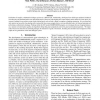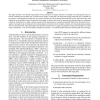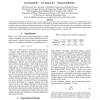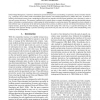LREC
2010
14 years 27 days ago
2010
Evaluation of complex, collaborative dialogue systems is a difficult task. Traditionally, developers have relied upon subjective feedback from the user, and parametrisation over o...
LREC
2010
14 years 27 days ago
2010
The fast evolution of language technology has produced pressing needs in standardization. The multiplicity of language resources representation levels and the specialization of th...
LREC
2010
14 years 27 days ago
2010
The SignSpeak project will be the first step to approach sign language recognition and translation at a scientific level already reached in similar research fields such as automat...
LREC
2010
14 years 27 days ago
2010
Transliteration is the rendering in one language of terms from another language (and, possibly, another writing system), approximating spelling and/or phonetic equivalents between...
LREC
2010
14 years 27 days ago
2010
Existing approaches to classifying documents by sentiment include machine learning with features created from n-grams and part of speech. This paper explores a different approach ...
LREC
2010
14 years 27 days ago
2010
This paper describes a new flexible representation for the annotation of complex structures of metadata over heterogeneous data collections containing text and other types of medi...
LREC
2010
14 years 27 days ago
2010
We investigate the impact of input data scale in corpus-based learning using a study style of Zipf's law. In our research, Chinese word segmentation is chosen as the study ca...
LREC
2010
14 years 27 days ago
2010
In this paper, we propose a scheme for annotating utterance-level units in Japanese dialogs, which emerged from an analysis of the interrelationship among four schemes, i) inter-p...
LREC
2010
14 years 27 days ago
2010
This paper describes recent efforts at Linguistic Data Consortium at the University of Pennsylvania to create manual transcripts as a shared resource for human language technology...
LREC
2010
14 years 27 days ago
2010
In Knowledge Management, variations in information expressions have proven a real challenge. In particular, classical semantic relations (e.g. synonymy) do not connect words with ...




